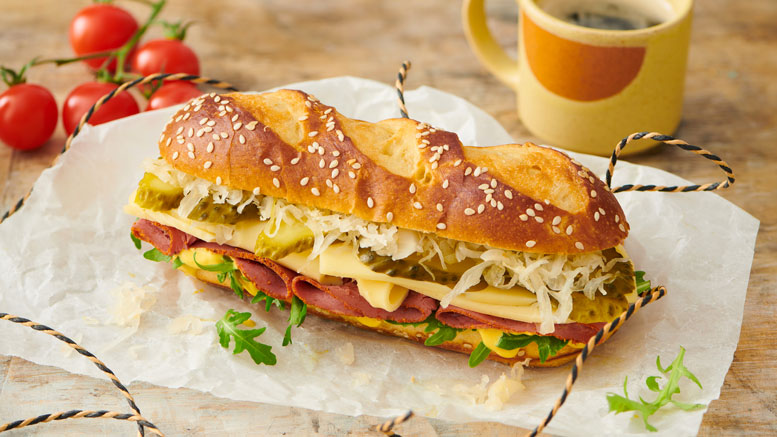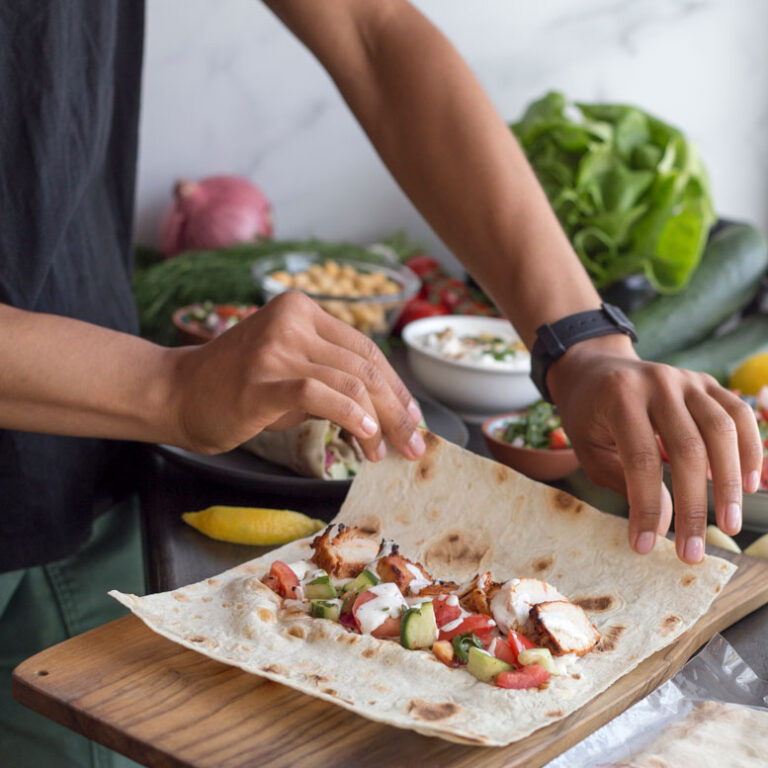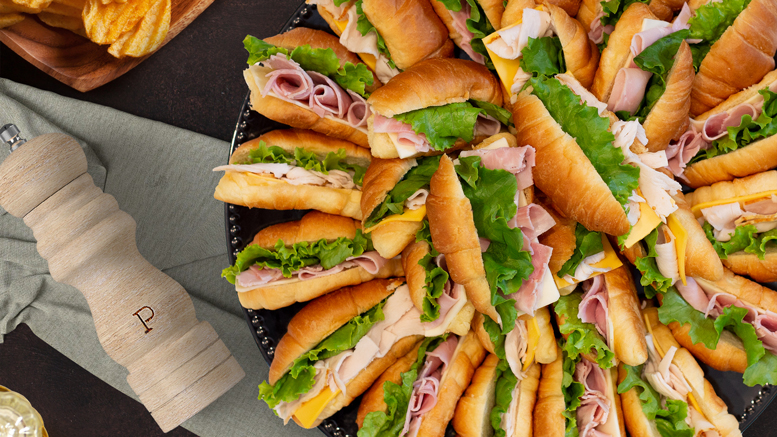Creating a Sandwich Destination in Deli
March 19, 2024 | 9 min to read
Supermarket delis can boost profits by developing a sandwich program, as indicated by a 7.1% increase in sandwich dollar sales in 2023. The International Dairy Deli Bakery Association highlights that 55% of households are purchasing deli sandwiches, with a notable 18.3% rise in unit sales over three years. Engaging customers through quality and variety is essential, with grab-and-go options being the least labor-intensive. Trends show a shift towards white meats and vegetarian options.

Providing a wide selection with complementary items can raise register rings.
Prepared food continues to be a growing category for supermarket delis. For stores that have not yet ventured into the segment, or even for retailers who have, creating a sandwich program is an effective way to create additional profits while highlighting the deli department’s offerings.
According to the Madison, WI-based International Dairy Deli Bakery Association (IDDBA), sandwich dollar sales in 2023 were up 7.1%, but unit sales were up just 1.6% due to inflation. In addition, 55% of households are buying deli sandwiches, which is a .5% increase versus a year ago. Unit sales have increased 18.3% compared to three years ago.
“There is slight growth, but supermarket delis need to find ways to appeal to folks who aren’t liking the current selection,” says Jack Ince, the IDDBA’s education coordinator.
Fortunately for supermarket delis, there are multiple ways to get into the game.
“As far as programs go, there are a few approaches,” says Ince. “First, the most popular is grab-and-go, with pre-made sandwiches ready [in the cooler]. Many prefer that from an operations standpoint since it requires the least amount of intensive labor.”
He adds that higher-end stores may delve into paninis and other hot sandwich varieties in a self-serve bar. Or, delis can go the traditional route and provide made-to-order sandwiches if labor is not an issue.
“However, today retailers prefer programs with a smaller footprint on the labor budget,” says Ince.
Grab-and-go requires the least amount of labor, since sandwiches are made in advance and can be prepared in bulk.
“The main challenge is making sure you keep customers engaged,” notes Ince. “Not everyone wants the same options, so delis need some variety.”
“Savvy retailers will look to engage shoppers through quality, consistency and in-store experiences that garner loyalty — and that can, and should — include sandwich programs in supermarket delis that offer great variety,” says Jake Huber, U.S. sales director, St Pierre Bakery, based in Manchester, England.
WHAT’S TRENDING
Top-selling sandwich ingredients have held steady over the years, although the toppings, spreads and carriers have changed.
According to IDDBA’s Ince, chicken and turkey are the top sandwiches in dollar and unit sales, with cheese and pork sandwiches on top for 2023.
“Outside of sandwiches, consumers are going away from red meat and toward white meat, and many are going to vegetarian options and also pork as the other white meat,” says Ince.

“As far as other new items, we talked about using brioche, pretzel and sourdough bread types, with more specific claims on types of bread being used to set sandwiches apart. There also is more value-added cheese like Gouda and mozzarella. The focus for toppings is on the sauces like anything with cranberry, aioli and other flavor-forward options.”
Dietary trends, such as keto and gluten-free, are impacting the sandwich segment in supermarket delis.
In response to this, Ridgefield, NJ-based Toufayan Bakeries offers keto and gluten-free wraps.
“We’ve seen more usage of items that we’ve had for a while now,” says Karen Toufayan, Toufayan Bakeries’ vice president of marketing and sales. “One is our mini croissant, with several retailers using this with chicken, ham and egg salad sandwiches and making party trays with them. In supermarkets down South, they are merchandised in coolers.”
She also is seeing increased popularity in the company’s authentic lavash bread, which is thin and flour-based.
“We’re seeing this being used in foodservice programs primarily in the Midwest, where we had a soft launch of the product,” Toufayan explains.
Traditional wrap sandwiches and sub sandwiches, along with party trays that have mini sandwiches using sweet breads, are still on trend.
“We have a ring bread that is a pull-apart bun type sandwich that is popular,” says Toufayan.
With many people now eating on the go, grab-and-go concepts are here to stay. Also, sandwich creativity continues to grow.
“People are eating in the car, on park benches or at their desk,” says Warren Stoll, marketing director, Kontos Foods Inc., headquartered in Paterson, NJ. “The only nuance to it is, as the world becomes more global, the ethnicity of what they eat changes.”
Kontos Foods’ flatbreads are used for a wide range of sandwich types, from gyros to falafels to kabobs to souvlaki.
“Our bread keeps heat and moisture within the sandwich when it’s wrapped up, which is good for on-the-go traffic,” says Stoll. “Everything we offer is hand-stretched for fluffiness. This starts as an individual dough ball, so it rises when proofed, creating air bubbles in the bread. We also add a little oil, so it remains soft and fluffy to maintain heat and moisture in the sandwich without the bread getting soggy.”
Retailers can use Kontos Foods’ panini bread — offered either with or without grill marks — for use on a panini grill or press.
“If the volume of the store is too high or there is no space for a panini grill, you don’t need a press with bread that has grill marks,” says Stoll. “Retailers also can load them in the glass case, but the question is how fast can you heat them up.”
Differentiating sandwich ingredients, as well as bread, is also effective.
“Changing up things like using different cheeses such as mozzarella and pepper jack with roasted red pepper and onions, along with swapping out meat and protein, makes a difference,” says Stoll.
“For consumers, the trend for premiumization is here to stay,” says Huber at St Pierre Bakery. “Previously, shoppers were elevating their meals at home because they couldn’t travel or dine out in the pandemic. Now that the cost of living is on the way up, consumers are still looking to treat themselves well at home. This is backed up by the data, too — with ‘specialty rolls’ growing in both value and volume (15% and 3% respectively) in the last year and ‘brioche’ as a category growing at 16%, (according to Nielsen’s Dec. 30, 2023 report).”

Last year, St Pierre launched its take on pretzel rolls, with the Brioche Pretzel Roll.
“Catering to the growing demand for specialty rolls, St Pierre’s delicately sweet brioche blends perfectly with the salty flavor of the pretzel glaze, with sesame seeds for added crunch,” says Huber. “Artisan breads are also growing in both value and volume in the last 52 weeks, and both of those bakery subsectors highlight the demand for products that offer quality, with new flavors and textures — an easy trend for supermarket delis to tap into.”
CREATING A DESTINATION
There are a number of ways supermarket delis can set their sandwich programs apart.
“For high-end paninis or hot sandwiches for grab-and-go, the benefit is you stand out more,” says IDDBA’s Ince. “This creates a destination, so much customization, a personalization element and variety.”
An easy way to provide this is by incorporating an LTO (limited time only) sandwich menu. This creates an urgency to visit the store within a certain period of time.
“Having a sandwich of the day or week also provides core shoppers that stop by frequently for meals with another option, like a turkey cranberry sandwich in November in honor of Thanksgiving,” says Ince.
Another way to differentiate a sandwich program is by offering a wide selection of bread types.
“Focaccia is very popular right now,” says Ince. “Retailers also can push the quality of ingredients to provide an everyday luxury.”
To set a program apart even more, retailers can incorporate technology such as kiosk apps or loyalty programs, along with catering and entertaining options.
“People are eating out less, so entertaining options are good to have,” notes Ince.
Toufayan at Toufayan Bakeries recommends retailers incorporate more signage in stores, which can provide added visibility for sandwich programs.
“I was on vacation ordering sandwiches for a boat trip, and you wouldn’t know the deli had a sandwich program due to limited signage,” she says. “Social media can play a role in that, as well. Stores have awesome baked goods in the bakery and quality meats and cheeses in the deli, but if a consumer doesn’t know, what’s the point.”
“Retailers offering a trade-up in one area of the grocery store can drive increased sales in other areas — and that’s why getting the offering right in bakery is paramount for retailers,” says Huber. “For example, a shopper who opts for a premium brioche burger bun from St Pierre is more likely to pair it with premium meats and cheeses. That applies equally to in-store foodservice options, particularly when you consider that using brands, like St Pierre, known for their superior quality, means retailers can command a higher price point on the menu.”
The convenience factor cannot be overlooked.
“Another reason that St Pierre works so well for retailers’ in-store sandwich programs is that our products offer speed and convenience, without compromising on quality,” says Huber. “St Pierre’s range of brioche burger buns, brioche hot dog rolls, brioche subs and brioche pretzel rolls are all pre-sliced, so they’re easy and quick to serve as part of a menu, while offering authentic, premium brioche to encourage increased spend.”
MARKETING & MERCHANDISING
Because sandwich program success hinges on increased visibility, special attention should be given to marketing and merchandising.
“There is increased opportunity pushing smaller-sized sandwiches, since snacking is on the rise,” says IDDBA’s Ince. “Delis can offer a half sandwich with sides from the hot bar.”
Smaller sandwiches also are easier to eat on the go, so these can be positioned in this way.
Also, with today’s inflation, emphasizing value and lower costs can be beneficial for these programs.
“Inflation drives folks to prepared meals, and it’s hard to find a better value [than a deli sandwich program],” notes Ince. “In addition, delis can capitalize on the international flavor trend with Cubanos or tortas, since taking inspiration is a great way to broaden a customer base.”
Supermarket delis also can establish a spoilage diversion program to control food waste, which impacts profits.
“Giving the deli team the flexibility at the store level to utilize ingredients close to expiration in sandwich programs is better than letting food go to waste,” says Ince.
Cross-merchandising and incorporating complementary products is typically an effective way to bring new life into a stale sandwich program.
“Retailers can bring in ethnic cheeses, olives and olive oil, and partner with meat providers, to get their creativity going,” says Kontos Foods’ Stoll. “Having different sandwich combinations or themed promotions makes a difference.”
Toufayan notes that bundling and cross-merchandising work well with sandwich programs.
“Retailers need to think outside the box. It’s not just about meat and cheese.”
— Karen Toufayan, Toufayan Bakeries, Ridgefield, NJ
“Retailers need to think outside the box,” she says. “It’s not just about meat and cheese.”
Also, upselling should not be ruled out, as putting the spotlight on premium products can create higher register rings.
“Our innovative merchandising solutions are encouraging shoppers to trade up in other parts of the store — pairing a premium bread carrier with more premium meats and cheeses,” says St Pierre Bakery’s Huber. “Cross-merchandising St Pierre products can also increase basket spend and that is particularly useful in the deli.”
Looking ahead, the future is bright for supermarket deli sandwich programs, as the prospects are there to succeed.
“There are a lot of opportunities for delis if we continue to have a higher cost of living or inflation concerns in 2024,” says IDDBA’s Ince. “Prepared foods have struck a strong value aspect, so that consumers will continue to see the strength of sandwiches.”
111 of 140 article in DeliBusiness Spring 2024

